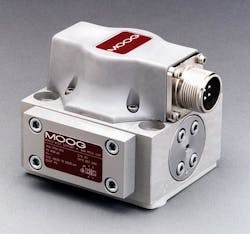Hydraulic servovalves can run for as long as 25 years. But why do they perform for so long, even in demanding applications like steelmaking and industrial production machinery?
The hydraulic servovalve is part of a closed-loop control system including electromechanical mechanisms and embedded software algorithms. The design, materials of construction, manufacturing processes ensure that it will maintain consistent performance over its expected lifetime.
Three keys to servo valve longevity
Three critical design aspects within the hydraulic servovalve lead to increased longevity, minimal downtime, and reliable performance. These include:
- a carbide ball on the feedback mechanism,
- ball-in-hole design in the spool, and
- brazing to bond the ball to the wire.
Carbide ball construction
Despite using precision machining processes over the years, Moog's servovalve designers discovered that premature wear of the ball in the feedback mechanism degraded the valve’s performance. Most early designs incorporated a stainless steel ball on the feedback mechanism that would wear out over time. Since the 1990s, carbide and sapphire materials have been introduced to replace stainless steel and provide extended protection to the ball.
Although sapphire is more expensive than carbide, it does not necessarily offer higher performance. In fact, engineers at Moog have evaluated the wear characteristics of a ball made of steel, carbide, and sapphire by subjecting each to one billion test cycles in a controlled environment with clean hydraulic fluids and temperatures held at a steady state. While the stainless steel ball revealed significant wear, the results confirmed that a carbide ball and sapphire ball did not show any signs of wear. In addition to being comparable in performance to sapphire and less costly, carbide material can also be bonded to the feedback mechanism wire by brazing. For cost control, carbide is the clear choice for ball design.
Ball-in-hole design
The ball-in-slot design was the industry standard for more than 40 years, but Moog engineers developed a carbide ball-in-hole design in 1998 to improve the longevity and reliability of their servovalves. This design reduces concentrated contact of the ball with the spool at any point on the surfaces – a process that radically improves the overall life expectancy of the servo valve by eliminating wear in the spool.
Engineers found that after one billion cycles in a controlled environment, the ball-in-slot designs showed visible wear marks in the spool slot, while the ball-in-hole configuration exhibited no signs of wear. In fact, failure of the ball-in-slot technology can occur in as few as 100 million cycles when a life expectancy should be one billion cycles.
In addition, further investigation concluded that adhesive wear (i.e., slow spool rotations between 1 and 4 rpm) cause the most significant damage to ball-in-slot designs, yet have minimal effect on the ball-in-hole configuration.
Today, many mechanical feedback servo valves have been converted to ball-in-hole technology due to its superior performance and extended lifetime in industrial applications.
Brazing is a specialized soldering process that joins the carbide ball and stainless steel wire at temperatures above 450 oF (232 oC). It involves heating a filler metal above melting point and distributing it between two or more close-fitting parts via capillary action to join the pieces together. This critical manufacturing process is only possible with carbide — not sapphire — and is critical in enabling the ball to withstand both high temperatures and deterioration from chemicals in the hydraulic fluids.
Engineers often use epoxy as a brazing alternative when joining the feedback mechanism ball and wire. This is commonly used when joining sapphire to a stainless steel wire, since sapphire cannot be brazed. Unfortunately, servo valve applications present other factors that cause unexpected failure for epoxy/sapphire techniques. In fact, tests show that the epoxy used to join the feedback mechanism ball and wire in sapphire ball-based mechanisms can break down even within normal operating temperatures between 0 oF (-17.7 o C) to 160 o F (71 o C).
Ensuring a long and reliable life
The selection of carbide material for the ball on the feedback mechanism, the incorporation of ball-in-hole spool design and the integration of brazing to bond the carbide ball to wire are essential for ensuring a servo valve has a long and reliable life.
As design engineers consider the components for machines, they should give servo valve construction a closer look. The latest testing shows that carbide is as durable as sapphire. Research also indicates manufacturers can bond carbide to the feedback mechanism wire with a brazing process. Brazing enables the component to withstand hydraulic fluids and high temperatures, of course. And the ball-in-hole design extends the life of the servo valve by eliminating wear in the spool. Examining the details of servo valve design and making an educated choice can maximize uptime for your application and revenue for your business. It’s the sort of feedback an engineer needs to pick a longer-lasting servo valve.
Click here to visit Moog's website for more details on its carbide ball construction.
Daniel Baran is Engineering Service Manager for the Mechanical Feedback Servo Valve Department at Moog Industrial Group., East Aurora, NY. For more information, call (716) 652 2000 or visit www.moog.com.





